1995 CHEVROLET CAVALIER check engine light
[x] Cancel search: check engine lightPage 30 of 340
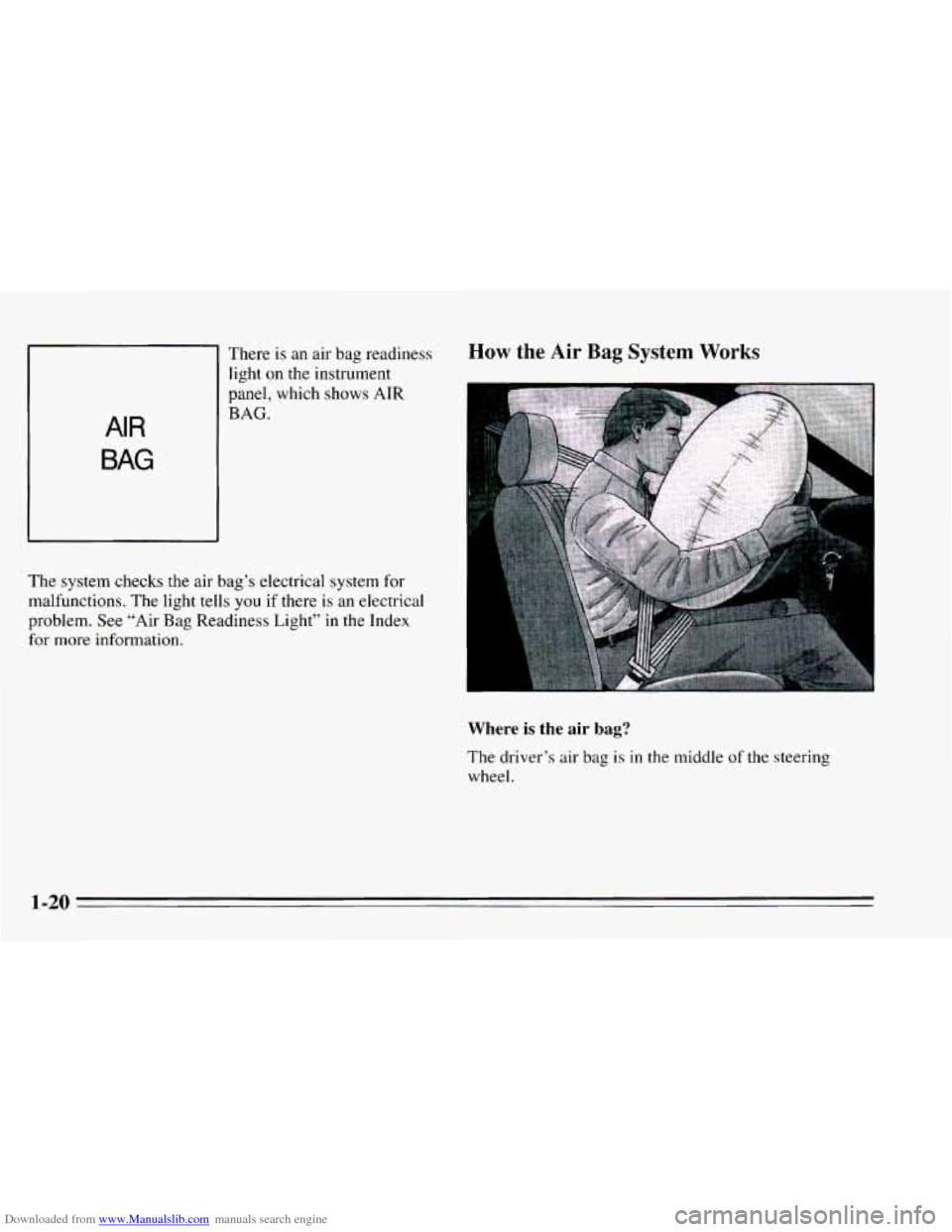
Downloaded from www.Manualslib.com manuals search engine There is an air bag readiness
light on the instrument
panel, which
shows AIR
AIR
BAG
BAG.
How the Air Bag System Works
The system checks the air bag’s electrical system for
malfunctions.
The light tells you if there is an electrical
problem. See “Air
Bag Readiness Light” in the Index
for more information.
Where is the air bag?
The driver’s air bag is in the middle of the steering
wheel.
1-20
Page 63 of 340
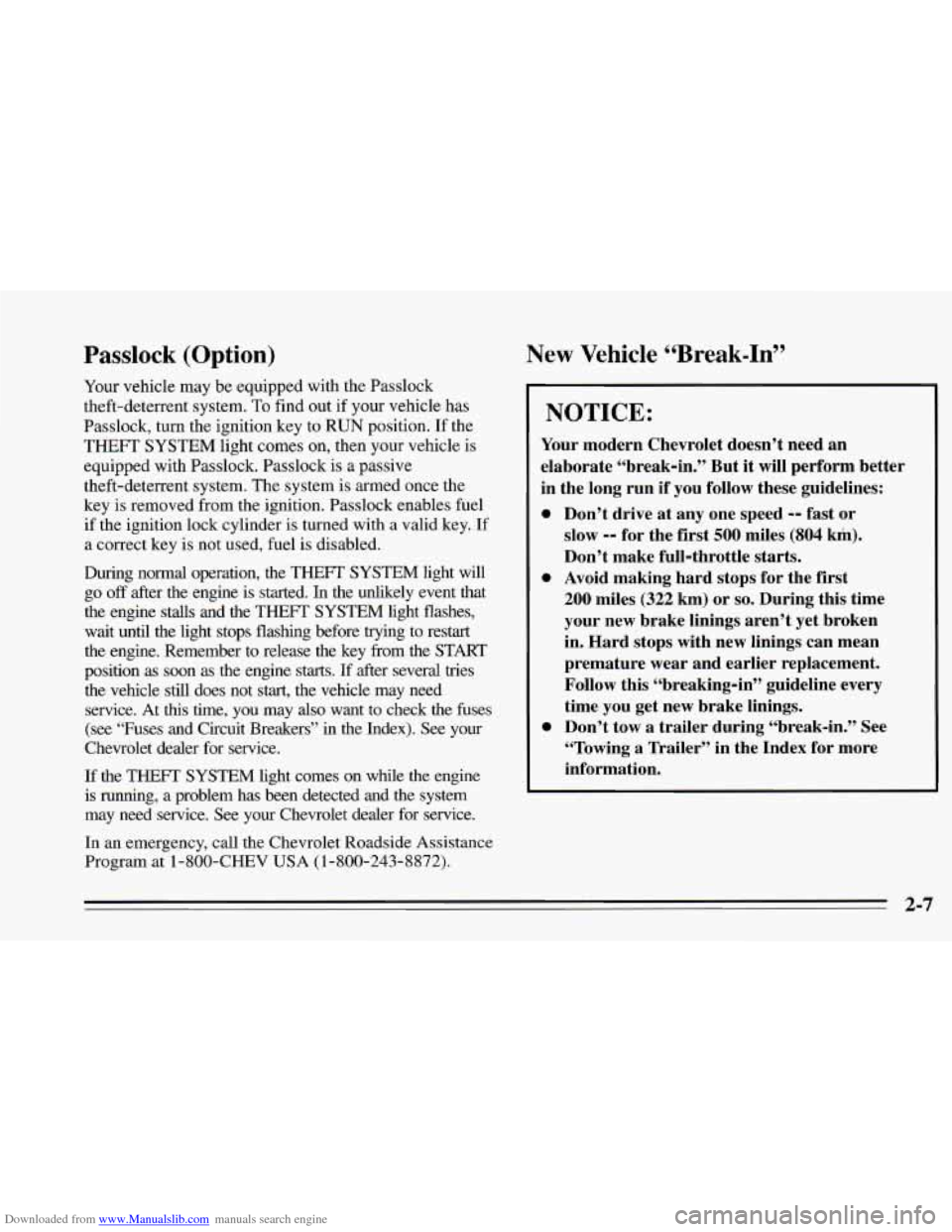
Downloaded from www.Manualslib.com manuals search engine Passlock (Option)
Your vehicle may be equipped with the Passlock
theft-deterrent system.
To find out if your vehicle has
Passlock, turn the ignition key to RUN position.
If the
THEFT SYSTEM light comes on, then your vehicle is
equipped with Passlock. Passlock
is a passive
theft-deterrent system. The system is armed once the
key is removed from the ignition. Passlock enables fuel
if the ignition lock cylinder is turned with a valid key. If
a correct key is not used, fuel is disabled.
During normal operation, the
THEFT SYSTEM light will
go
off after the engine is started. In the unlikely event that
the engine stalls and the
THEFI’ SYSTEM light flashes,
wait until the light stops flashing before
trying to restart
the engine. Remember to release the key from.the START
position
as soon as the engine starts. If after several tries
the vehicle still does not start, the vehicle may need
service. At
this the, you may also want to check the fuses
(see “Fuses and Circuit Breakers” in the Index).
See your
Chevrolet dealer for service.
If the THEFT SYSTEM light comes on while the engine
is running, a problem has been detected and
the system
may need service. See your Chevrolet dealer for service.
In an emergency, call the Chevrolet Roadside Assistance
Program at 1-800-CHEV USA (1-800-243-8872).
New Vehicle “Break-In”
Your modern Chevrolet doesn’t need an
elaborate “break-in.” But it will perform better
in the long run if you follow these guidelines:
e
e
0
Don’t drive at any one speed -- fast or
slow
-- for the first 500 miles (804 h).
Don’t make full-throttle starts.
Avoid making hard stops for the
first
200 miles (322 km) or so. During this time
your new brake linings aren’t yet broken
in. Hard stops with new linings can mean
premature wear and earlier replacement.
Follow this “breaking-in” guideline every
time you get new brake linings.
Don’t tow a trailer during “break-in.” See
“Towing a Trailer’’ in the Index for more
information.
2-7
Page 68 of 340
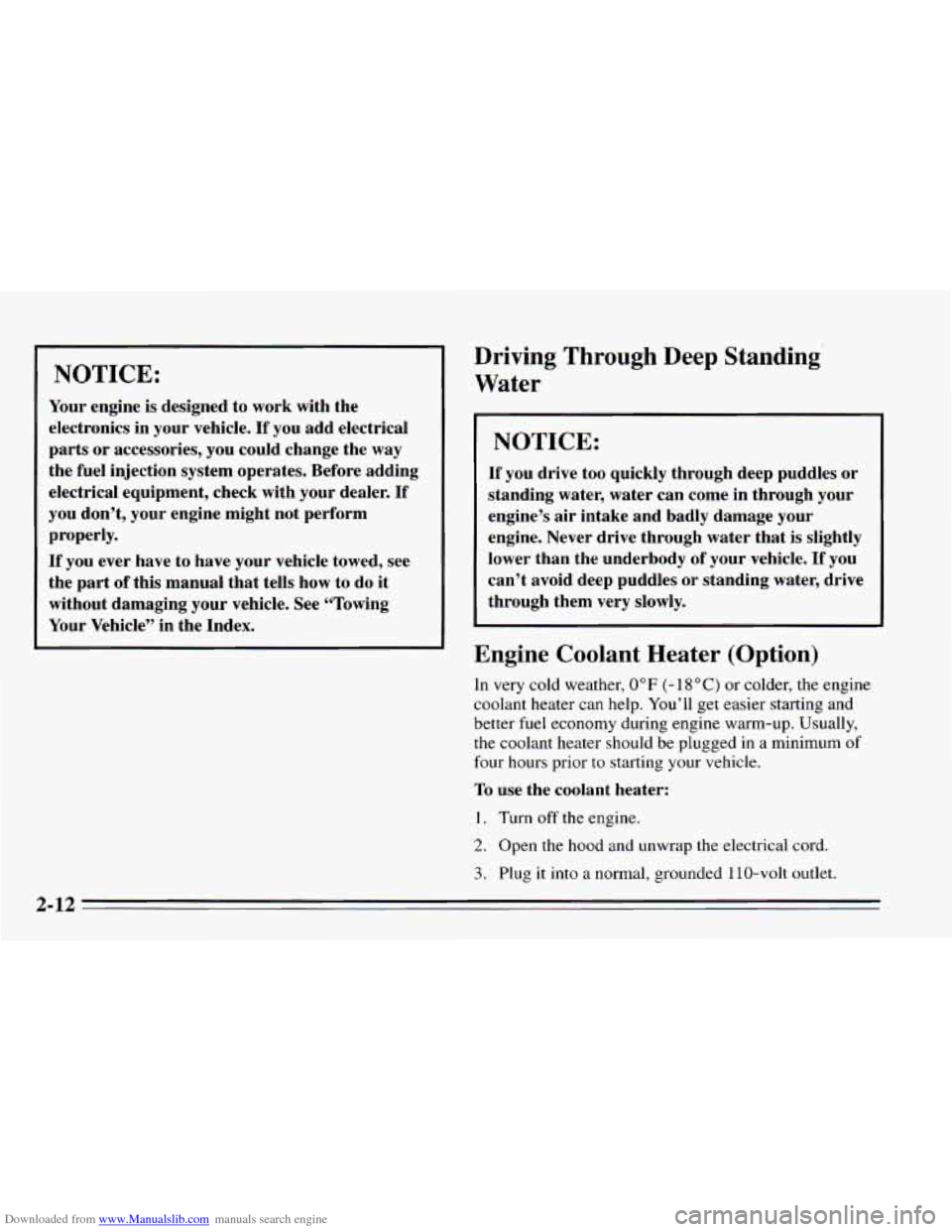
Downloaded from www.Manualslib.com manuals search engine NOTICE:
Your engine is designed to work with the
electronics in your vehicle.
If you add electrical
parts or accessories, you could change the
way
the fuel injection system operates. Before adding
electrical equipment, check with your dealer. If
you don’t, your engine might not perform
properly.
If you ever have to have your vehicle towed, see
the part of this manual that tells how to do
it
without damaging your vehicle. See “Towing
Your Vehicle” in the Index.
Driving Through Deep Standing
Water
I
I NOTICE:
If you drive too quickly through deep puddles or
standing water, water can come in through your engine’s air intake and badly damage your
engine. Never drive through water that is slightly
lower than the underbody
of your vehicle. If you
can’t avoid deep puddles or standing water, drive
through them very slowly.
Engine Coolant Heater (Option)
In very cold weather, 0°F (- 18°C) or colder, the engine
coolant heater can help. You’ll get easier starting and
better fuel economy during engine warm-up. Usually,
the coolant heater should be plugged in a minimum of
four hours prior to starting your vehicle.
To use the coolant heater:
I. Turn off the engine.
2. Open the hood and unwrap the electrical cord.
3. Plug it into a normal, grounded 110-volt outlet.
2-12
Page 117 of 340
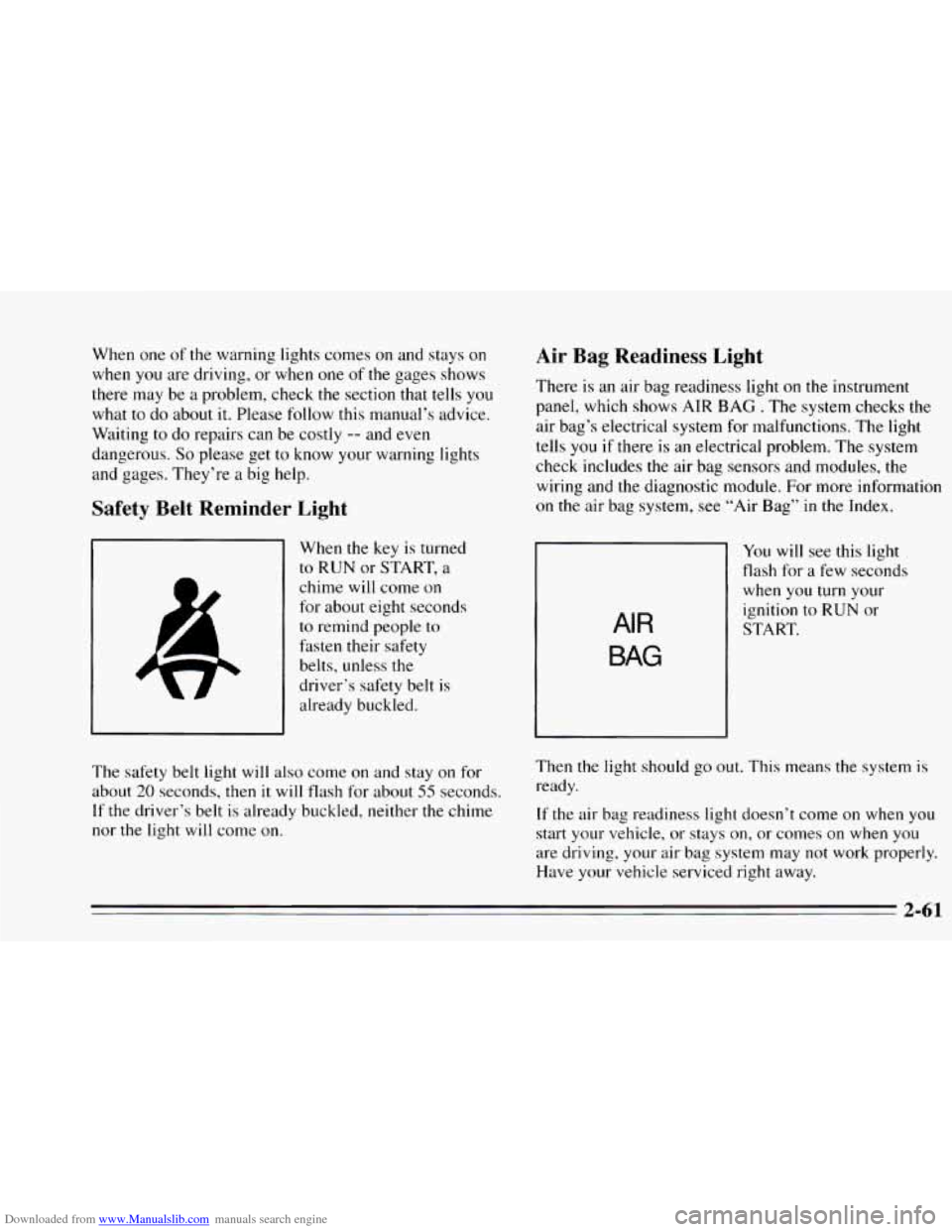
Downloaded from www.Manualslib.com manuals search engine When one of the warning lights comes on and stays on
when
you are driving, or when one of the gages shows
there may be a problem, check
the section that tells you
what to do about
it. Please follow this manual’s advice.
Waiting to do repairs can be costly
-- and even
dangerous.
So please get to know your warning lights
and gages. They’re
a big help.
Safety Belt Reminder Light
When the key is turned
to RUN or START, a
chime will come on
for about eight seconds
to remind people to
fasten their safety
belts, unless
the
driver’s safety belt is
already buckled.
Air Bag Readiness Light
There is an air bag readiness light on the instrument
panel, which shows AIR
BAG . The system checks the
air bag’s electrical system for malfunctions. The light
tells
you if there is an electrical problem. The system
check includes the air bag sensors and modules, the
wiring and the diagnostic module.
For more information
on the air bag system, see “Air Bag” in the Index.
rl
You will see this light
flash for
a few seconds
when you turn your
ignition
to RUN or
AIR
BAG
START.
The safety belt light
will also come on and stay on for
about
20 seconds, then it will flash for about 55 seconds.
If the driver’s belt is already buckled, neither the chime
nor
the light will come on. Then
the light should
go out. This means the system is
ready.
If the air bag readiness light doesn’t come on when you
start your vehicle, or stays on, or comes on
when you
are driving. your air bag system may not work properly.
Have your vehicle serviced right away.
2-61
Page 120 of 340
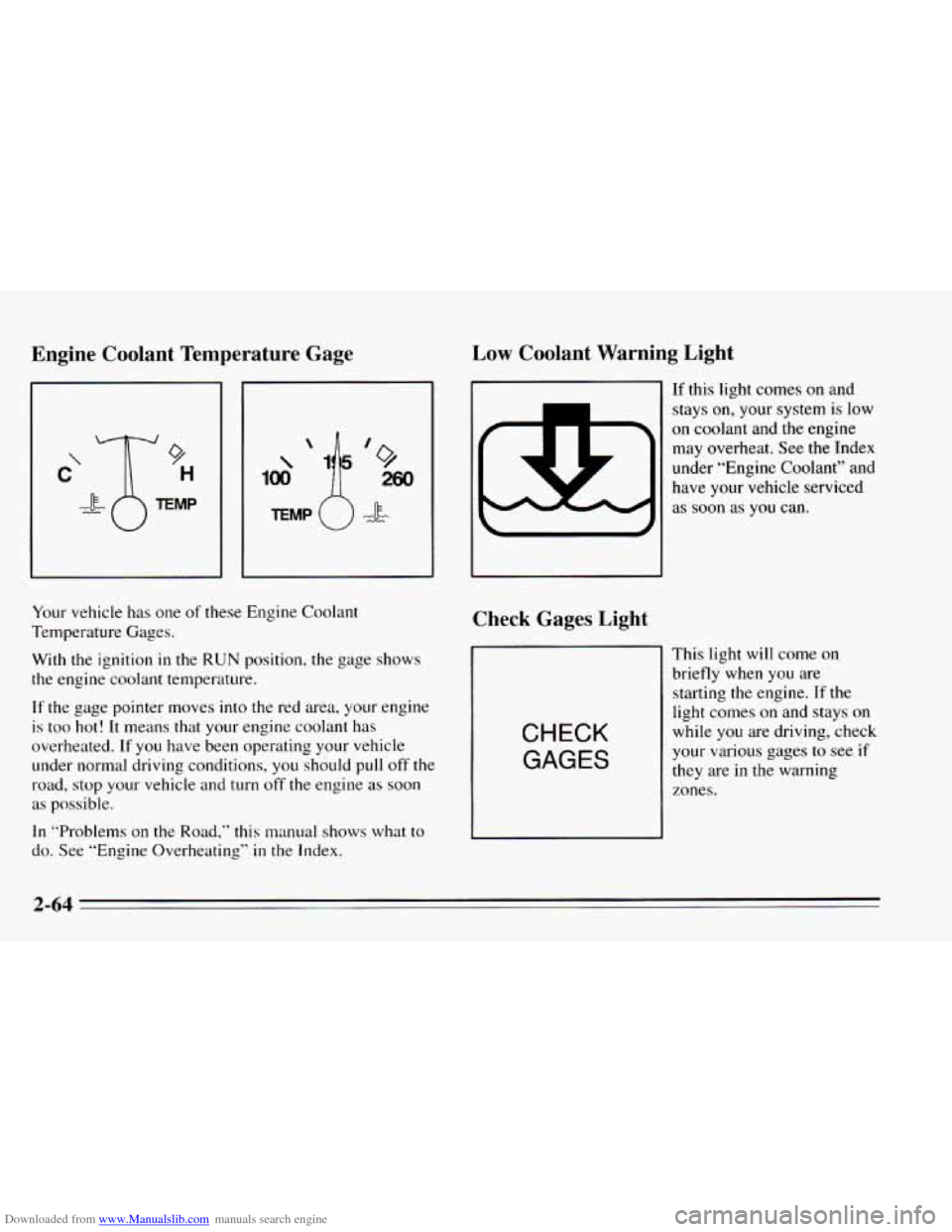
Downloaded from www.Manualslib.com manuals search engine Engine Coolant Temperature Gage
100 \‘+’” 260
Your vehicle has one of these Engine Coolant
Temperature Gages.
With the ignition
in the RUN position, the gage shows
the engine coolant temperature.
If the gage pointer tnoves into the red area, your engine
is too
hot! It means that your engine coolant has
overheated.
If you have been operating your vehicle
under normal driving conditions, you should pull
off’ the
road, stop your vehicle and turn
off’ the engine as soon
as possible.
In “Problems on the Road,“ this manual shows what to
do. See “Engine Overheating”
in the Index.
Low Coolant Warning Light
Check Gages Light
CHECK
GAGES
If this light comes on and
stays on, your system is low
on coolant and the engine
may overheat. See the Index
under “Engine Coolant” and
have your vehicle serviced
as soon as you can.
This light will come on
briefly when
you are
starting the engine.
If the
light comes on and stays
on
while you are driving, check
your various gages
to see if
they are in the warning
I
zones.
2-64
Page 122 of 340
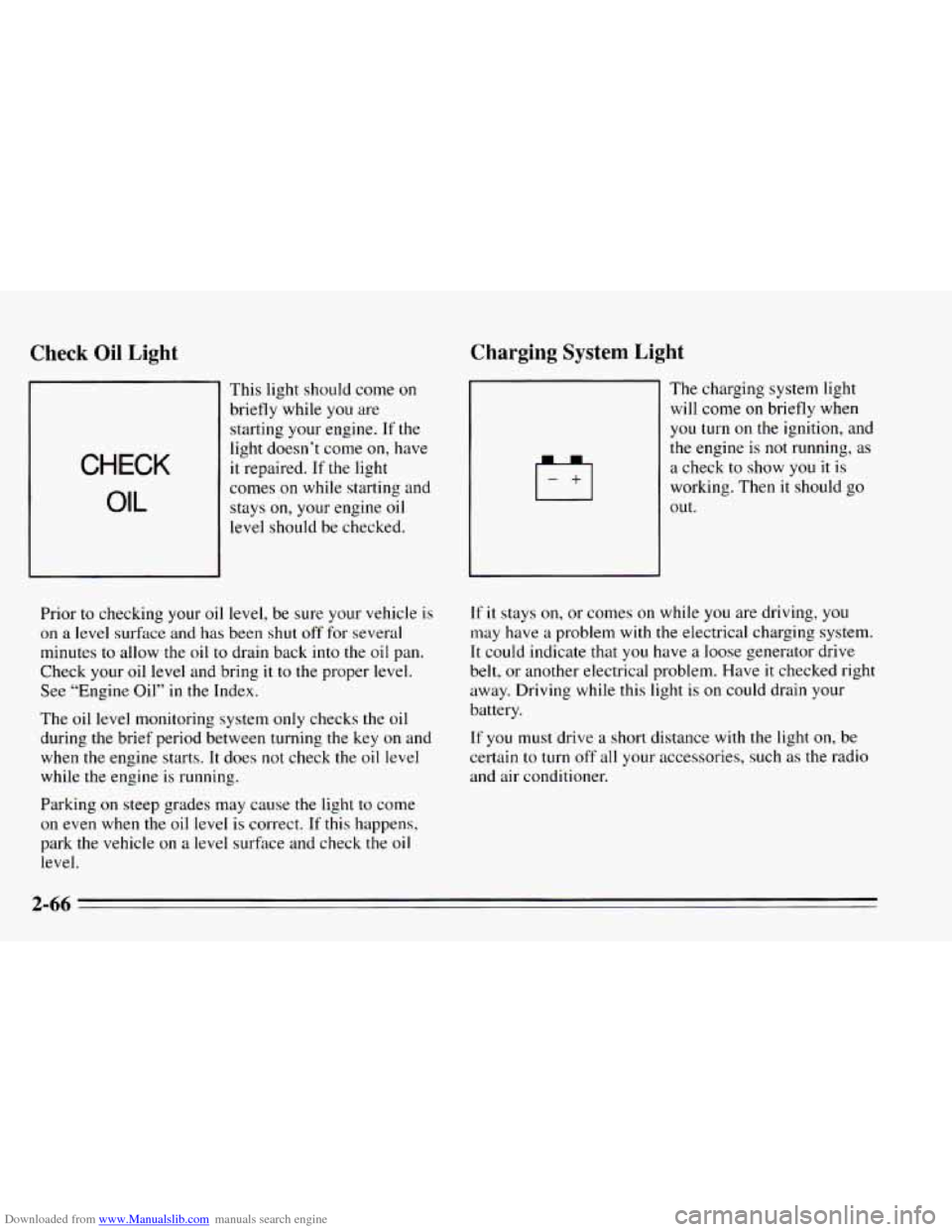
Downloaded from www.Manualslib.com manuals search engine Check Oil Light
CHECK
OIL
This light should come on
briefly while you are
starting your engine.
If the
light doesn’t come
on, have
it repaired. If the light
comes
on while starting and
stays
on, your engine oil
level should be checked.
Charging System Light
The charging system light
will come
on briefly when
you turn on the ignition, and
the engine is not running, as
a check to show you
it is
working. Then it should
go
out.
Prior to checking your oil level, be sure your vehicle is
on
a level surface and has been shut off for several
minutes to allow the oil
to drain back into the oil pan.
Check your oil level and bring
it to the proper level.
See “Engine Oil” in
the Index.
The oil level monitoring system
only checks the oil
during the brief period between turning the key on and
when the engine starts.
It does not check the oil level
while the engine is running.
Parking
on steep grades may cause the light to come
on even when the oil level is correct. If this happens,
park the vehicle on a level surface and check the oil
level.
If it stays on, or comes on while you are driving, you
may have
a problem with the electrical charging system.
It could indicate that you have a loose generator drive
belt, or another electrical problem. Have
it checked right
away. Driving while this light
is on could drain your
battery.
If you must drive a short distance with the light on, be
certain
to turn off all your accessories, such as the radio
and air conditioner.
2-66
Page 124 of 340
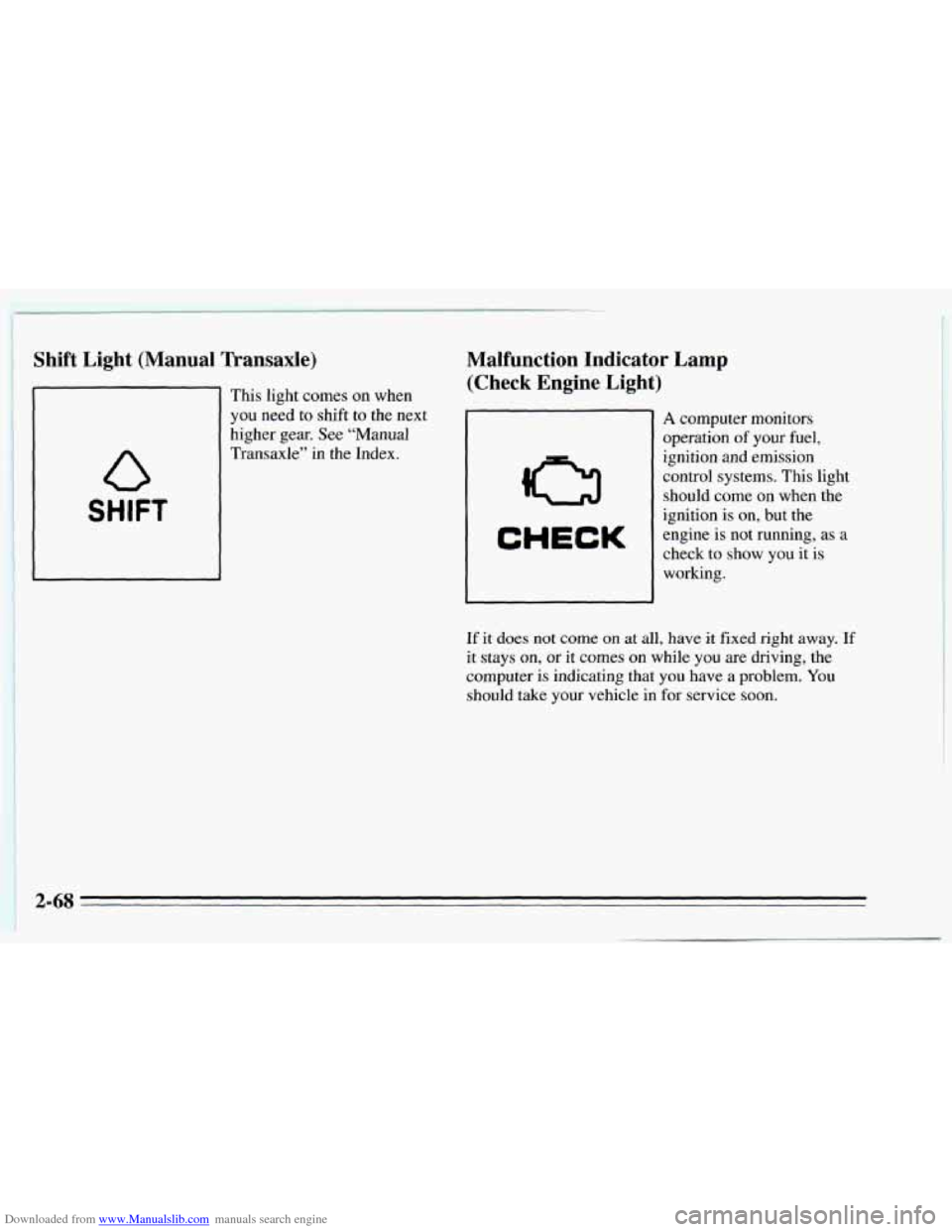
Downloaded from www.Manualslib.com manuals search engine i Shift Light (Manual Transaxle)
SHIFT
This light comes on when
you need to shift
to the next
higher gear. See “Manual
Transaxle” in the Index.
Malfunction Indicator Lamp
(Check Engine Light)
r A computer monitors
operation
of your fuel,
ignition and emission
control systems. This light
should come
on when the
ignition
is on, but the
engine is not running,
as a
check to show
you it is
working.
If it does not come on at all, have it fixed right away. If
it stays on, or it comes on while you are driving, the
computer is indicating that you have a problem. You
should take your vehicle in for service soon.
Page 125 of 340

Downloaded from www.Manualslib.com manuals search engine NOTICE:
If you keep driving your vehicle with this light
on, after a while the emission controls won’t
work as well, your fuel economy won’t
be as good
and your engine may not run as smoothly. This
could lead to costly repairs not covered by your
warranty.
If Your Vehicle
Is Equipped with OBD I1
(2.3L Code D Engine Only)
Certain vehicles are equipped with a new emission
diagnostic system. You can tell whether your vehicle has
this system by reading your tune-up label located under
the hood. If the label says
“OBD 11” on it. the following
instructions apply.
Your Chevrolet
is equipped with an onboard computer
which monitors operation
of the emission control
system. This system
is called OBD I1 (On-Board
Diagnostics
-- Second Generation) and is intended to
assure that emissions are at acceptable levels for the life
of the vehicle, helping to produce a cleaner
environment. The
CHECK ENGINE light comes on to
indicate when service is require.d. Malfunctions often
will be indicated by the system before any problem is apparent,
which may prevent more serious damage
tc,
your vehicle. This system is also designed to assist your
service technician
in correctly diagnosing any
malfunction.
The
CHECK ENGINE light should come on, as a check
to show
you it is working, when the ignition is on and
the engine is
not running. This light will also come on
during a malfunction in one of two ways:
Light On Steady: This indicates a system
malfunction has been detected. Drive the vehicle
to
the dealer for service at your first opportunity.
Light Flashing: This indicates a misfire has been
detected which may damage the emission control
system. The damage may be reduced by Iowering the
vehicle speed, reducing the amount
of cargo being
hauled or trailered, avoiding hard acceleration,
or by
avoiding steep uphill grades.
If these actions are
effective,
the light will stop flashing and remain on
steady. Drive the vehicle to a dealer for service. If
the light continues to flash, stop the vehicle. Wait for
a steady light to come on, then drive the vehicle to
a
dealer for service.
2-69